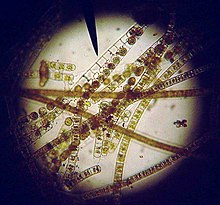Green algae
The chloroplasts in dinoflagellates of the genus Lepidodinium, euglenids and chlorarachniophytes were acquired from ingested endosymbiont green algae,[9] and in the latter retain a nucleomorph (vestigial nucleus).
Green algae are also found symbiotically in the ciliate Paramecium, and in Hydra viridissima and in flatworms.
Trentepohlia is a filamentous green alga that can live independently on humid soil, rocks or tree bark or form the photosymbiont in lichens of the family Graphidaceae.
[12][13] The cell walls of green algae usually contain cellulose, and they store carbohydrate in the form of starch.
Members of the class Chlorophyceae undergo closed mitosis in the most common form of cell division among the green algae, which occurs via a phycoplast.
[16] By contrast, charophyte green algae and land plants (embryophytes) undergo open mitosis without centrioles.
[21][20][22][23][5][24][25][26][27][28][29][30][1][excessive citations] Palmophyllophyceae (prasinophyte clade VI) Prasinodermophyceae Ulvophyceae Chlorophyceae Trebouxiophyceae Chlorodendrophyceae Pedinophyceae Prasinophytes Clade VIIA Prasinophytes Clade VIIC Pycnococcaceae Nephroselmidophyceae Mamiellophyceae Pyramimonadales Mesostigmatophyceae Spirotaenia Chlorokybophyceae Streptofilum Klebsormidiophyceae Charophyceae Coleochaetophyceae Zygnematophyceae Mesotaeniaceae s.s. Embryophyta (land plants) The basal character of the Mesostigmatophyceae, Chlorokybophyceae and spirotaenia are only more conventionally basal Streptophytes.
[31] Green algae are a group of photosynthetic, eukaryotic organisms that include species with haplobiontic and diplobiontic life cycles.
However, these traits show some variation, most notably among the basal green algae called prasinophytes.
Sex pheromone production is likely a common feature of green algae, although only studied in detail in a few model organisms.
One well-studied species, Volvox carteri (2,000 – 6,000 cells) occupies temporary pools of water that tend to dry out in the heat of late summer.
However, they are able to escape death by switching, shortly before drying is complete, to the sexual phase of their life cycle that leads to production of dormant desiccation-resistant zygotes.
[36] The green algae, including the characean algae, have served as model experimental organisms to understand the mechanisms of the ionic and water permeability of membranes, osmoregulation, turgor regulation, salt tolerance, cytoplasmic streaming, and the generation of action potentials.



